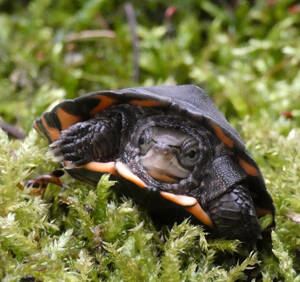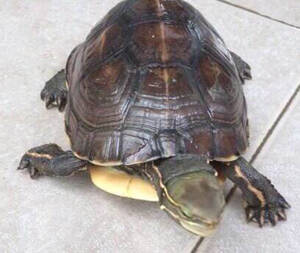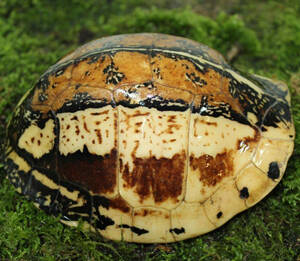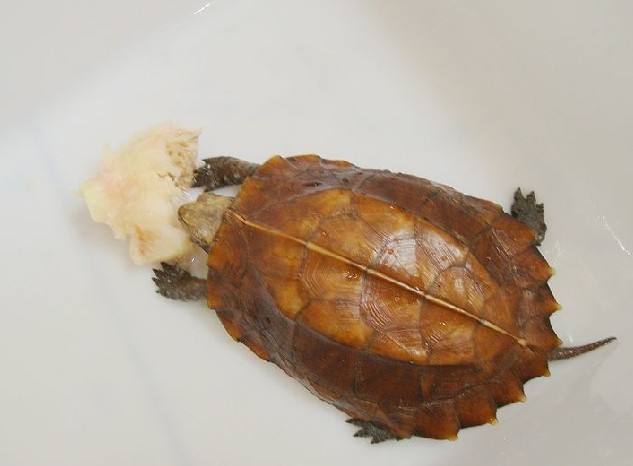Cuora picturata
IUCN
LCBasic Information
Scientific classification
- name:Cuora picturata
- Scientific Name:Cuora picturata,Southern Vietnam Box Turtle,Annam's box turtle
- Outline:Testudines
- Family:Testudinidae B.turtle
Vital signs
- length:15-19cm
- Weight:About 1100g
- lifetime:30-50years
Feature
Cream or yellow head, cream belly, with a large black spot on each scale
Distribution and Habitat
The patterned box turtle is only found in Khanh Hoa and Phu Yen provinces in Vietnam, and may also appear in Dong Da Lak and Bac Ninh provinces.
Appearance
The genus Ceratosaurus is a medium-sized tortoise, with a carapace of about 15-19 cm and weighing up to 1100 grams. Males and females are about the same size. Hatchlings are about 45-50 mm long and weigh 15-24 grams. The carapace is orange-brown to dark brown, with papillary bands running along the sides of each rib. It has a cream or yellow head with a subtle gray reticulation, and a cream-colored abdomen with a large black spot on each scale. Males generally have a slightly more concave plastron than females, larger claws, and a longer, thicker tail.
Details
The foreign name of the patterned box turtle is Southern Vietnam Box Turtle, and there is no subspecies.
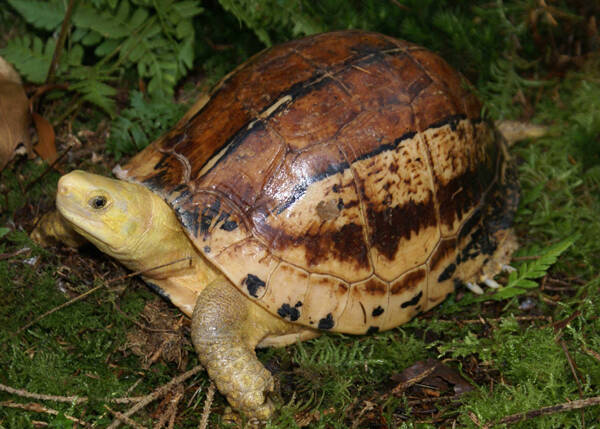
The patterned box turtle was previously published as the yellow-fronted box turtle pictorial subspecies (Cuora galbinifrons picturata), and in 2004 Stuart and Parram (Stuart & Parham promoted it to an independent species; in 2006, Fritz et al. questioned its independent species status; in 2012, Spinks et al. published a paper acknowledging its independent species status, which was accepted by TTWG (2014).
The patterned box turtle is similar to the yellow-fronted box turtle (Cuora galbinifrons) and the Brandt's box turtle (Cuora bourreti). The difference between the three is that the yellow-fronted box turtle has a completely black plastron, while the other two have a light yellow plastron with large black spots. The Brandt's box turtle has a brighter head color, a larger body than the patterned box turtle, and a slightly longer oval shape. The patterned box turtle is slightly brighter than the Brandt's box turtle, has a smaller body, and is more round.
The patterned box turtle lives in the tropical evergreen forests of the Langbi Plateau in south-central Vietnam, at an altitude of 300-600 meters. The habitat temperature is 24-30℃ and the relative humidity is 65-80%. It is omnivorous and eats raw meat, small fish, shrimp, fruits, and vegetables. It can also be fed artificial bait.
Little information is known about the reproduction of the patterned box turtle in the wild. Under artificial captive breeding conditions, adult females can lay 1-3 eggs per year, and the size of large eggs can reach 60 mm × 35 mm. After the egg is fertilized, a white spot will form on the top of the egg, which will develop into a band within two to three days. The incubation period is 86-107 days.
As of 2016, the remaining suitable habitat for the species covers less than 3,000 square kilometers, and it is estimated that the global wild population may be less than 25,000, with a maximum of 3,000-10,000 surviving in the wild. The habitat has been greatly reduced due to deforestation and population pressure. The last protected forest reserve, known as the natural habitat, was completely burned in 2014.
In order to prevent the decline of various wild turtles and restore the number of wild turtle populations, Vietnam has formulated a national plan for the protection of endangered turtles. On July 16, 2019, the Ministry of Natural Resources and Environment of Vietnam and relevant institutions and organizations jointly launched the five-year action plan "to protect Vietnam's endangered turtles by 2025". The goals of this plan are: to improve laws and regulations as a guide for endangered turtle protection; to strengthen turtle surveys, assessments and research, especially to give priority to endangered species; to establish effective protection areas and organize rescue teams to breed and protect endangered turtle species; and to strengthen the effectiveness of management and enforcement of laws on the protection of rare turtles, and to encourage people to actively participate in various turtle protection activities.
The patterned box turtle often dies suddenly during the breeding process, and is called the "king of sudden death". Generally, it takes more than 3 years of domestication to basically stabilize, that is, it will die within 3 years. This is because the patterned box turtle has strict requirements on the environment and weak digestive function. It either does not open its mouth or eats greedily. Many turtles are timid and shrink their heads when they see people. The main reason for sudden death is that the turtles caught from the wild are stimulated by temperature differences during transportation and temporary breeding, feces and leftover bait are not cleaned up in time, cold water is rinsed, packaging is squeezed, ice is added for transportation, and water is injected artificially. Stress accumulates continuously. When the turtle cannot regulate itself, it will turn into malignant stress. It is common that there are no symptoms on the body surface after stress, and the internal organs have necrosis. When you see a turtle in breeding that is fine in the morning and suddenly dies in the afternoon, it means that the stress has accumulated for a long time and the liver and lung function have failed. Post-mortem autopsy found erosion of the internal organs.
Listed in the "Red List of Endangered Species of the World Conservation Union" (IUCN 2018 ver 3.1) - Critically Endangered (CR).
Listed in the "Convention on International Trade in Endangered Species of Wild Fauna and Flora" (CITES) - Appendix I.
Listed in the "Catalogue of Benchmark Value Standards for Aquatic Wildlife" (August 27, 2019).
Listed in Appendix I, Appendix II and Appendix III of the Convention on International Trade in Endangered Species of Wild Fauna and Flora (CITES) 2019 Edition
Protect wildlife and eliminate game.
Maintaining ecological balance is everyone's responsibility!



